Medication Errors in Healthcare: Prevention via Tech & Training
VerifiedAdded on 2023/06/10
|15
|3895
|182
Essay
AI Summary
This position paper examines the critical issue of medication errors in healthcare, highlighting their impact on patient safety and the overall cost of care. It emphasizes that medication errors are largely preventable through the strategic application of technology and comprehensive training for nursing professionals. The paper delves into the causes of these errors, including high workloads, inadequate training, and reliance on colleagues rather than evidence-based resources. Counterarguments, such as errors occurring across the healthcare system, are addressed, with a focus on the unique challenges faced by nurses administering a high volume of medications. The paper advocates for the adoption of technologies like Computerized Provider Order Entry (CPOE) systems and smart infusion pumps, while acknowledging their limitations and the need for effective human resource management to support their implementation. Ultimately, the paper argues that a combination of technological advancements and robust training programs is essential for minimizing medication errors and improving patient outcomes, despite the challenges associated with these interventions.
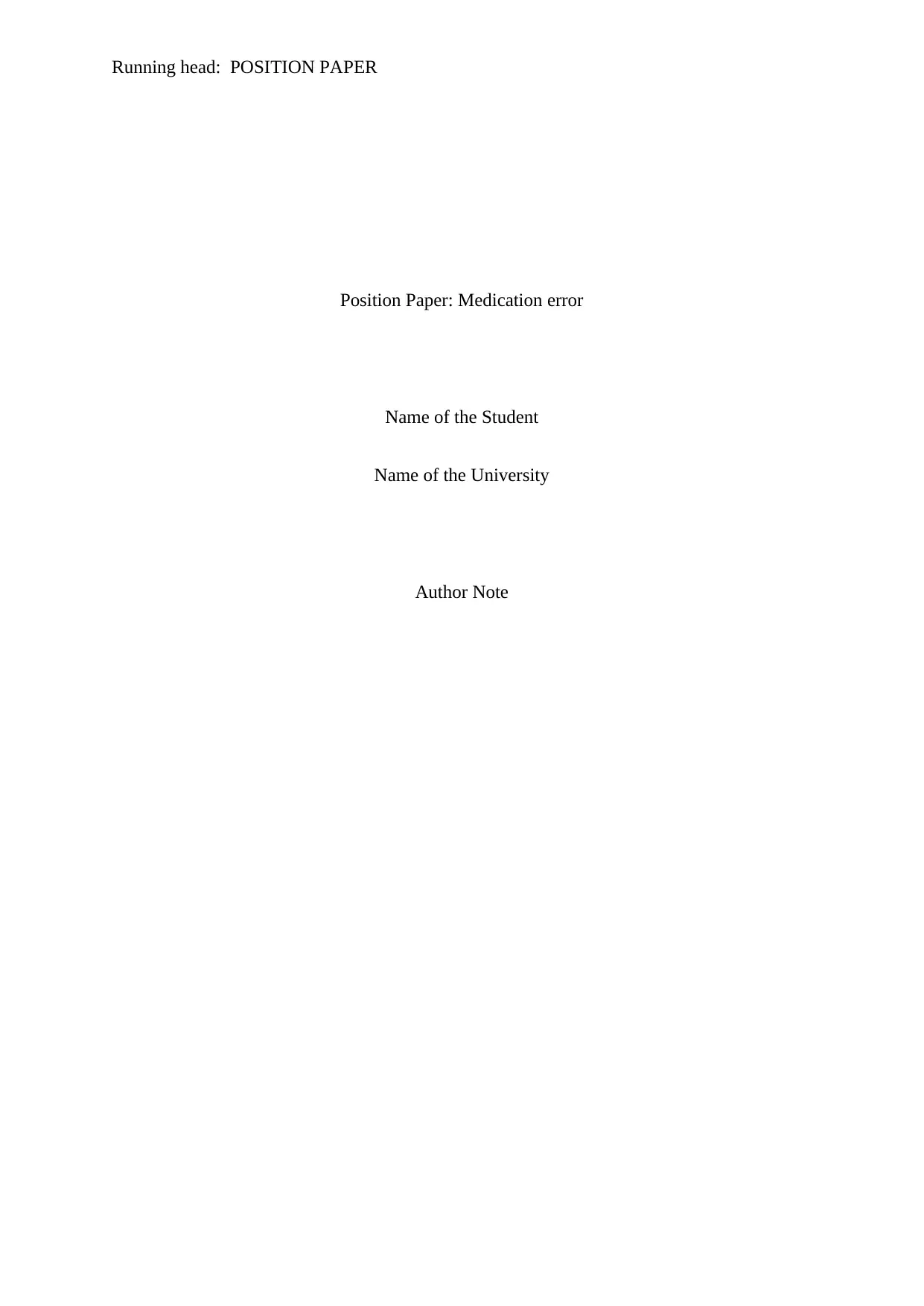
Running head: POSITION PAPER
Position Paper: Medication error
Name of the Student
Name of the University
Author Note
Position Paper: Medication error
Name of the Student
Name of the University
Author Note
Paraphrase This Document
Need a fresh take? Get an instant paraphrase of this document with our AI Paraphraser
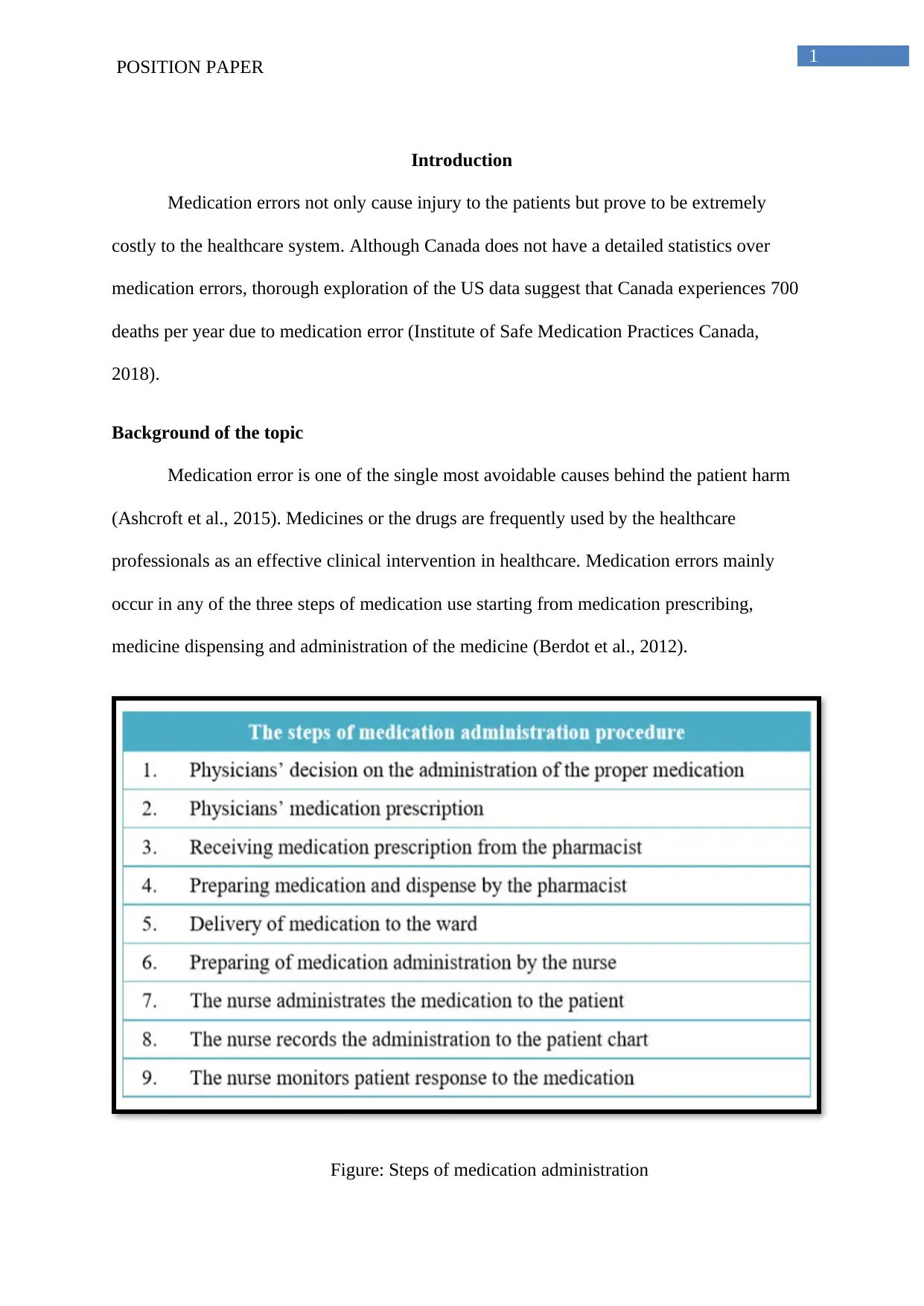
1
POSITION PAPER
Introduction
Medication errors not only cause injury to the patients but prove to be extremely
costly to the healthcare system. Although Canada does not have a detailed statistics over
medication errors, thorough exploration of the US data suggest that Canada experiences 700
deaths per year due to medication error (Institute of Safe Medication Practices Canada,
2018).
Background of the topic
Medication error is one of the single most avoidable causes behind the patient harm
(Ashcroft et al., 2015). Medicines or the drugs are frequently used by the healthcare
professionals as an effective clinical intervention in healthcare. Medication errors mainly
occur in any of the three steps of medication use starting from medication prescribing,
medicine dispensing and administration of the medicine (Berdot et al., 2012).
Figure: Steps of medication administration
POSITION PAPER
Introduction
Medication errors not only cause injury to the patients but prove to be extremely
costly to the healthcare system. Although Canada does not have a detailed statistics over
medication errors, thorough exploration of the US data suggest that Canada experiences 700
deaths per year due to medication error (Institute of Safe Medication Practices Canada,
2018).
Background of the topic
Medication error is one of the single most avoidable causes behind the patient harm
(Ashcroft et al., 2015). Medicines or the drugs are frequently used by the healthcare
professionals as an effective clinical intervention in healthcare. Medication errors mainly
occur in any of the three steps of medication use starting from medication prescribing,
medicine dispensing and administration of the medicine (Berdot et al., 2012).
Figure: Steps of medication administration
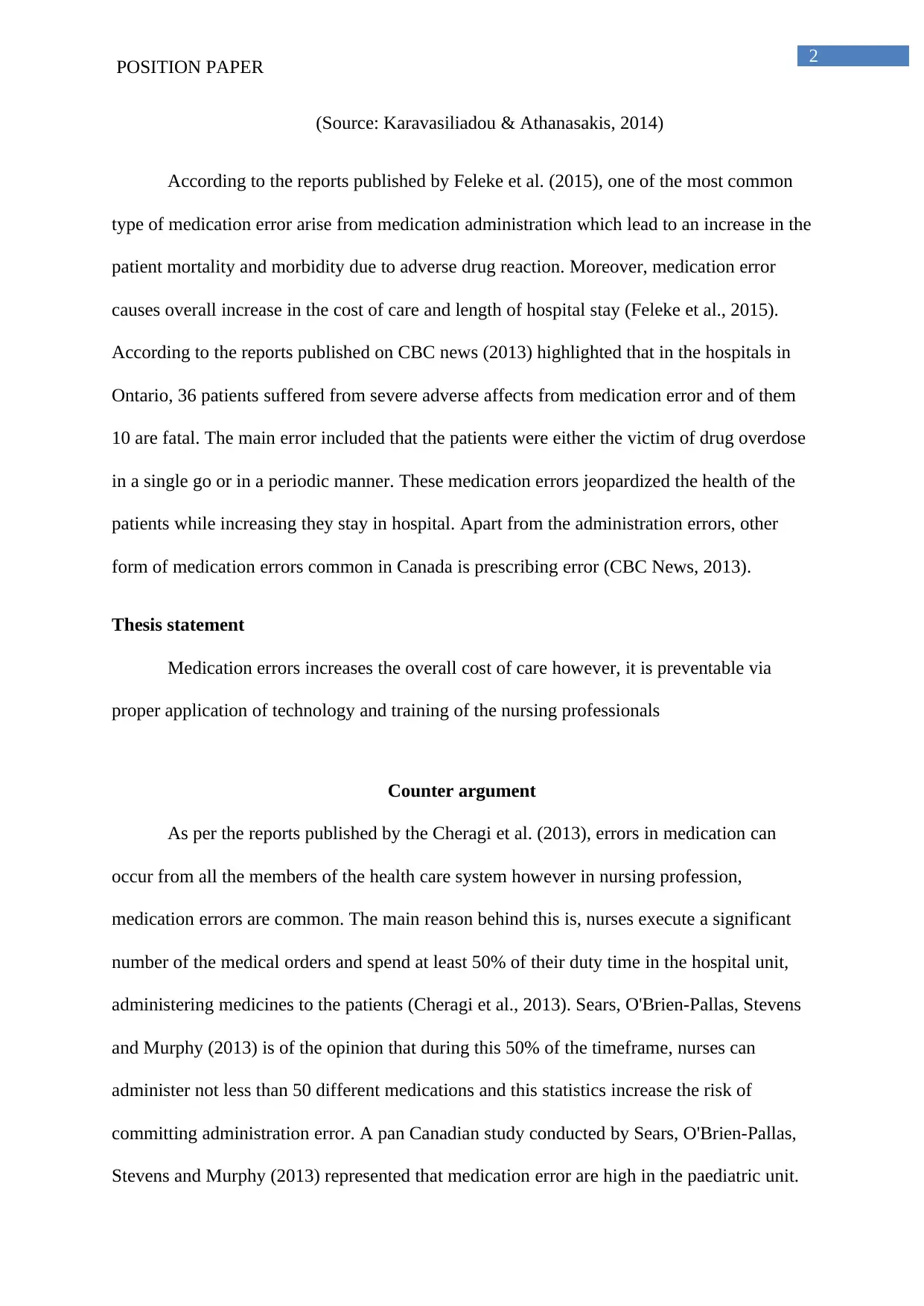
2
POSITION PAPER
(Source: Karavasiliadou & Athanasakis, 2014)
According to the reports published by Feleke et al. (2015), one of the most common
type of medication error arise from medication administration which lead to an increase in the
patient mortality and morbidity due to adverse drug reaction. Moreover, medication error
causes overall increase in the cost of care and length of hospital stay (Feleke et al., 2015).
According to the reports published on CBC news (2013) highlighted that in the hospitals in
Ontario, 36 patients suffered from severe adverse affects from medication error and of them
10 are fatal. The main error included that the patients were either the victim of drug overdose
in a single go or in a periodic manner. These medication errors jeopardized the health of the
patients while increasing they stay in hospital. Apart from the administration errors, other
form of medication errors common in Canada is prescribing error (CBC News, 2013).
Thesis statement
Medication errors increases the overall cost of care however, it is preventable via
proper application of technology and training of the nursing professionals
Counter argument
As per the reports published by the Cheragi et al. (2013), errors in medication can
occur from all the members of the health care system however in nursing profession,
medication errors are common. The main reason behind this is, nurses execute a significant
number of the medical orders and spend at least 50% of their duty time in the hospital unit,
administering medicines to the patients (Cheragi et al., 2013). Sears, O'Brien-Pallas, Stevens
and Murphy (2013) is of the opinion that during this 50% of the timeframe, nurses can
administer not less than 50 different medications and this statistics increase the risk of
committing administration error. A pan Canadian study conducted by Sears, O'Brien-Pallas,
Stevens and Murphy (2013) represented that medication error are high in the paediatric unit.
POSITION PAPER
(Source: Karavasiliadou & Athanasakis, 2014)
According to the reports published by Feleke et al. (2015), one of the most common
type of medication error arise from medication administration which lead to an increase in the
patient mortality and morbidity due to adverse drug reaction. Moreover, medication error
causes overall increase in the cost of care and length of hospital stay (Feleke et al., 2015).
According to the reports published on CBC news (2013) highlighted that in the hospitals in
Ontario, 36 patients suffered from severe adverse affects from medication error and of them
10 are fatal. The main error included that the patients were either the victim of drug overdose
in a single go or in a periodic manner. These medication errors jeopardized the health of the
patients while increasing they stay in hospital. Apart from the administration errors, other
form of medication errors common in Canada is prescribing error (CBC News, 2013).
Thesis statement
Medication errors increases the overall cost of care however, it is preventable via
proper application of technology and training of the nursing professionals
Counter argument
As per the reports published by the Cheragi et al. (2013), errors in medication can
occur from all the members of the health care system however in nursing profession,
medication errors are common. The main reason behind this is, nurses execute a significant
number of the medical orders and spend at least 50% of their duty time in the hospital unit,
administering medicines to the patients (Cheragi et al., 2013). Sears, O'Brien-Pallas, Stevens
and Murphy (2013) is of the opinion that during this 50% of the timeframe, nurses can
administer not less than 50 different medications and this statistics increase the risk of
committing administration error. A pan Canadian study conducted by Sears, O'Brien-Pallas,
Stevens and Murphy (2013) represented that medication error are high in the paediatric unit.
⊘ This is a preview!⊘
Do you want full access?
Subscribe today to unlock all pages.

Trusted by 1+ million students worldwide
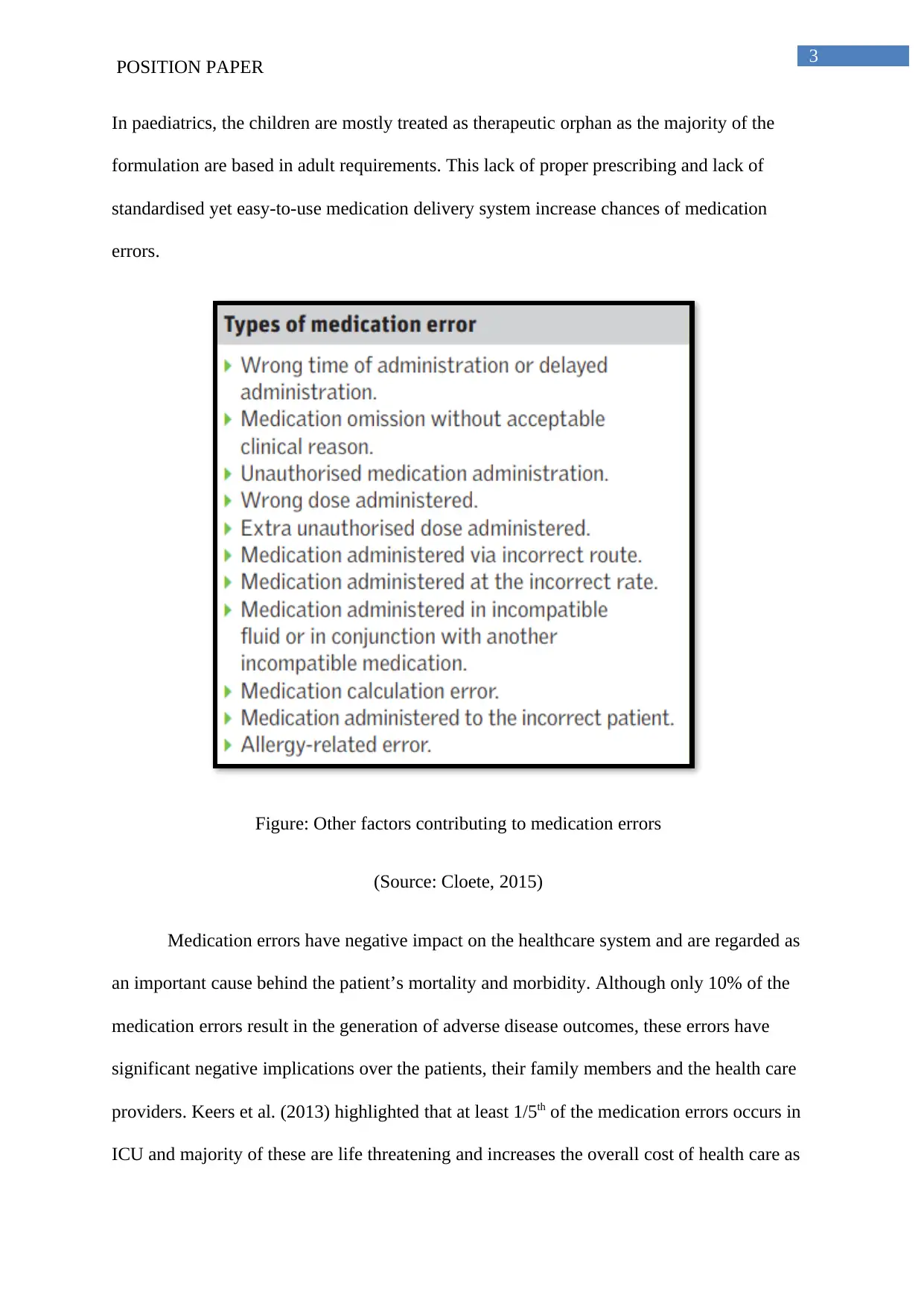
3
POSITION PAPER
In paediatrics, the children are mostly treated as therapeutic orphan as the majority of the
formulation are based in adult requirements. This lack of proper prescribing and lack of
standardised yet easy-to-use medication delivery system increase chances of medication
errors.
Figure: Other factors contributing to medication errors
(Source: Cloete, 2015)
Medication errors have negative impact on the healthcare system and are regarded as
an important cause behind the patient’s mortality and morbidity. Although only 10% of the
medication errors result in the generation of adverse disease outcomes, these errors have
significant negative implications over the patients, their family members and the health care
providers. Keers et al. (2013) highlighted that at least 1/5th of the medication errors occurs in
ICU and majority of these are life threatening and increases the overall cost of health care as
POSITION PAPER
In paediatrics, the children are mostly treated as therapeutic orphan as the majority of the
formulation are based in adult requirements. This lack of proper prescribing and lack of
standardised yet easy-to-use medication delivery system increase chances of medication
errors.
Figure: Other factors contributing to medication errors
(Source: Cloete, 2015)
Medication errors have negative impact on the healthcare system and are regarded as
an important cause behind the patient’s mortality and morbidity. Although only 10% of the
medication errors result in the generation of adverse disease outcomes, these errors have
significant negative implications over the patients, their family members and the health care
providers. Keers et al. (2013) highlighted that at least 1/5th of the medication errors occurs in
ICU and majority of these are life threatening and increases the overall cost of health care as
Paraphrase This Document
Need a fresh take? Get an instant paraphrase of this document with our AI Paraphraser
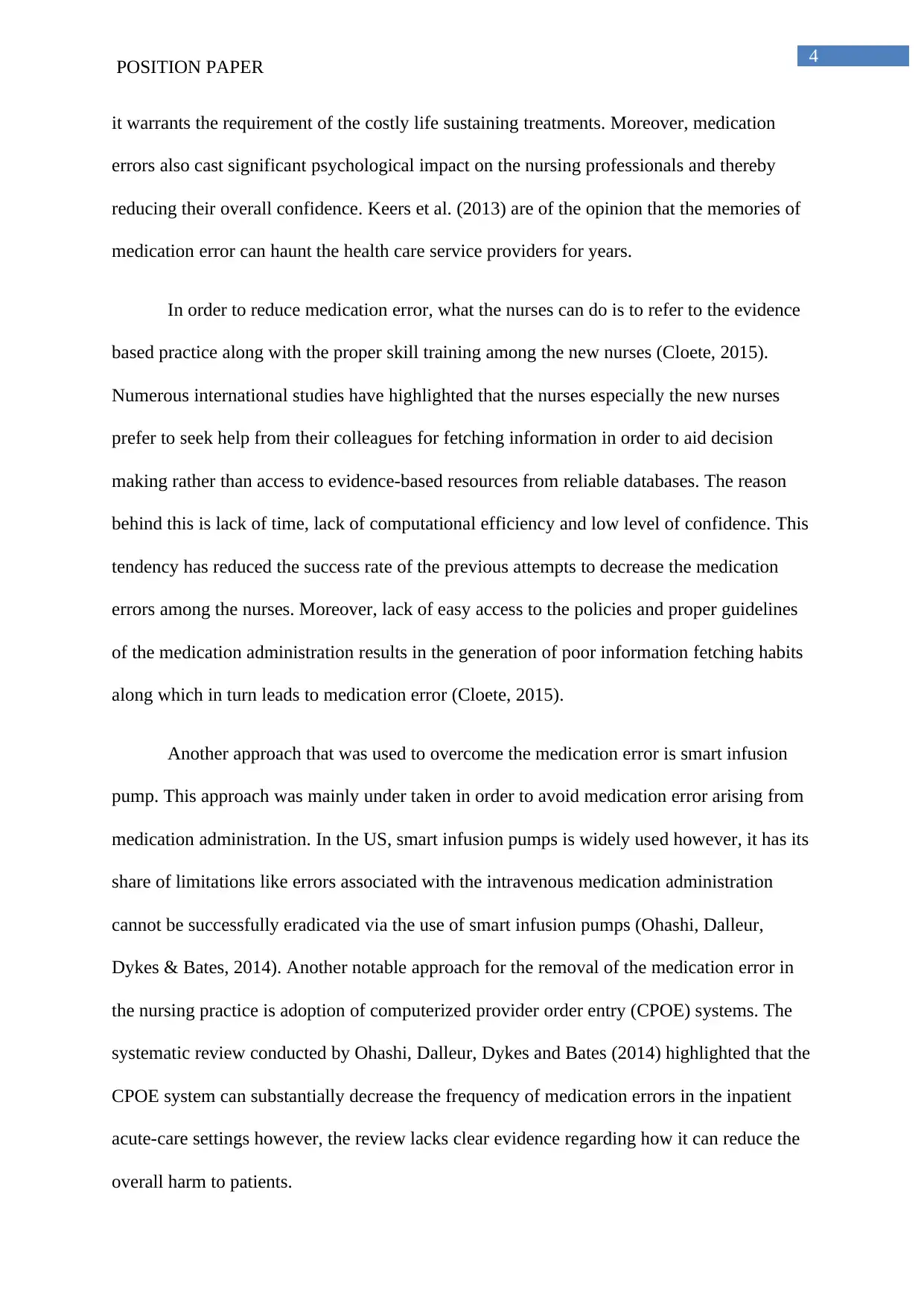
4
POSITION PAPER
it warrants the requirement of the costly life sustaining treatments. Moreover, medication
errors also cast significant psychological impact on the nursing professionals and thereby
reducing their overall confidence. Keers et al. (2013) are of the opinion that the memories of
medication error can haunt the health care service providers for years.
In order to reduce medication error, what the nurses can do is to refer to the evidence
based practice along with the proper skill training among the new nurses (Cloete, 2015).
Numerous international studies have highlighted that the nurses especially the new nurses
prefer to seek help from their colleagues for fetching information in order to aid decision
making rather than access to evidence-based resources from reliable databases. The reason
behind this is lack of time, lack of computational efficiency and low level of confidence. This
tendency has reduced the success rate of the previous attempts to decrease the medication
errors among the nurses. Moreover, lack of easy access to the policies and proper guidelines
of the medication administration results in the generation of poor information fetching habits
along which in turn leads to medication error (Cloete, 2015).
Another approach that was used to overcome the medication error is smart infusion
pump. This approach was mainly under taken in order to avoid medication error arising from
medication administration. In the US, smart infusion pumps is widely used however, it has its
share of limitations like errors associated with the intravenous medication administration
cannot be successfully eradicated via the use of smart infusion pumps (Ohashi, Dalleur,
Dykes & Bates, 2014). Another notable approach for the removal of the medication error in
the nursing practice is adoption of computerized provider order entry (CPOE) systems. The
systematic review conducted by Ohashi, Dalleur, Dykes and Bates (2014) highlighted that the
CPOE system can substantially decrease the frequency of medication errors in the inpatient
acute-care settings however, the review lacks clear evidence regarding how it can reduce the
overall harm to patients.
POSITION PAPER
it warrants the requirement of the costly life sustaining treatments. Moreover, medication
errors also cast significant psychological impact on the nursing professionals and thereby
reducing their overall confidence. Keers et al. (2013) are of the opinion that the memories of
medication error can haunt the health care service providers for years.
In order to reduce medication error, what the nurses can do is to refer to the evidence
based practice along with the proper skill training among the new nurses (Cloete, 2015).
Numerous international studies have highlighted that the nurses especially the new nurses
prefer to seek help from their colleagues for fetching information in order to aid decision
making rather than access to evidence-based resources from reliable databases. The reason
behind this is lack of time, lack of computational efficiency and low level of confidence. This
tendency has reduced the success rate of the previous attempts to decrease the medication
errors among the nurses. Moreover, lack of easy access to the policies and proper guidelines
of the medication administration results in the generation of poor information fetching habits
along which in turn leads to medication error (Cloete, 2015).
Another approach that was used to overcome the medication error is smart infusion
pump. This approach was mainly under taken in order to avoid medication error arising from
medication administration. In the US, smart infusion pumps is widely used however, it has its
share of limitations like errors associated with the intravenous medication administration
cannot be successfully eradicated via the use of smart infusion pumps (Ohashi, Dalleur,
Dykes & Bates, 2014). Another notable approach for the removal of the medication error in
the nursing practice is adoption of computerized provider order entry (CPOE) systems. The
systematic review conducted by Ohashi, Dalleur, Dykes and Bates (2014) highlighted that the
CPOE system can substantially decrease the frequency of medication errors in the inpatient
acute-care settings however, the review lacks clear evidence regarding how it can reduce the
overall harm to patients.
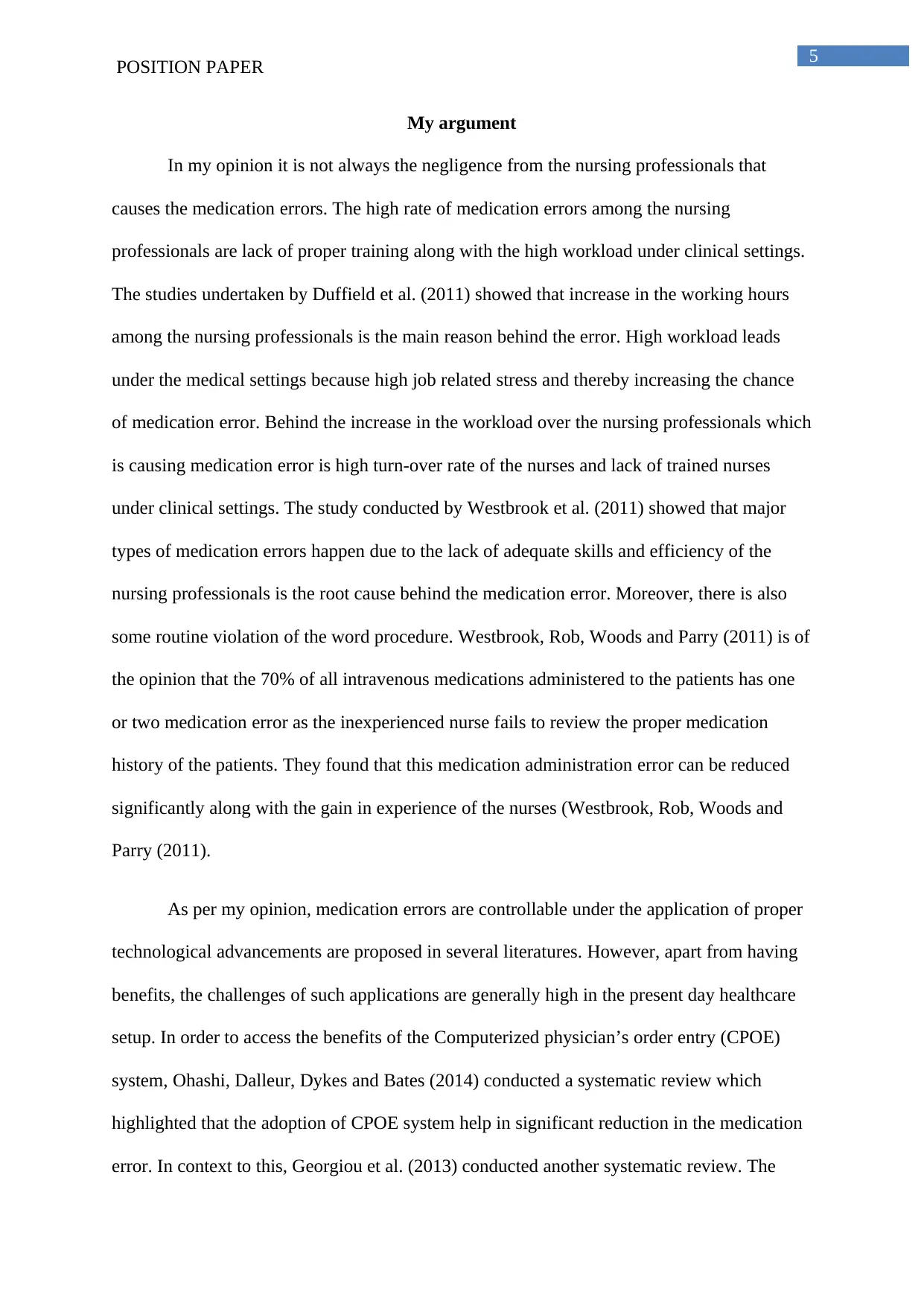
5
POSITION PAPER
My argument
In my opinion it is not always the negligence from the nursing professionals that
causes the medication errors. The high rate of medication errors among the nursing
professionals are lack of proper training along with the high workload under clinical settings.
The studies undertaken by Duffield et al. (2011) showed that increase in the working hours
among the nursing professionals is the main reason behind the error. High workload leads
under the medical settings because high job related stress and thereby increasing the chance
of medication error. Behind the increase in the workload over the nursing professionals which
is causing medication error is high turn-over rate of the nurses and lack of trained nurses
under clinical settings. The study conducted by Westbrook et al. (2011) showed that major
types of medication errors happen due to the lack of adequate skills and efficiency of the
nursing professionals is the root cause behind the medication error. Moreover, there is also
some routine violation of the word procedure. Westbrook, Rob, Woods and Parry (2011) is of
the opinion that the 70% of all intravenous medications administered to the patients has one
or two medication error as the inexperienced nurse fails to review the proper medication
history of the patients. They found that this medication administration error can be reduced
significantly along with the gain in experience of the nurses (Westbrook, Rob, Woods and
Parry (2011).
As per my opinion, medication errors are controllable under the application of proper
technological advancements are proposed in several literatures. However, apart from having
benefits, the challenges of such applications are generally high in the present day healthcare
setup. In order to access the benefits of the Computerized physician’s order entry (CPOE)
system, Ohashi, Dalleur, Dykes and Bates (2014) conducted a systematic review which
highlighted that the adoption of CPOE system help in significant reduction in the medication
error. In context to this, Georgiou et al. (2013) conducted another systematic review. The
POSITION PAPER
My argument
In my opinion it is not always the negligence from the nursing professionals that
causes the medication errors. The high rate of medication errors among the nursing
professionals are lack of proper training along with the high workload under clinical settings.
The studies undertaken by Duffield et al. (2011) showed that increase in the working hours
among the nursing professionals is the main reason behind the error. High workload leads
under the medical settings because high job related stress and thereby increasing the chance
of medication error. Behind the increase in the workload over the nursing professionals which
is causing medication error is high turn-over rate of the nurses and lack of trained nurses
under clinical settings. The study conducted by Westbrook et al. (2011) showed that major
types of medication errors happen due to the lack of adequate skills and efficiency of the
nursing professionals is the root cause behind the medication error. Moreover, there is also
some routine violation of the word procedure. Westbrook, Rob, Woods and Parry (2011) is of
the opinion that the 70% of all intravenous medications administered to the patients has one
or two medication error as the inexperienced nurse fails to review the proper medication
history of the patients. They found that this medication administration error can be reduced
significantly along with the gain in experience of the nurses (Westbrook, Rob, Woods and
Parry (2011).
As per my opinion, medication errors are controllable under the application of proper
technological advancements are proposed in several literatures. However, apart from having
benefits, the challenges of such applications are generally high in the present day healthcare
setup. In order to access the benefits of the Computerized physician’s order entry (CPOE)
system, Ohashi, Dalleur, Dykes and Bates (2014) conducted a systematic review which
highlighted that the adoption of CPOE system help in significant reduction in the medication
error. In context to this, Georgiou et al. (2013) conducted another systematic review. The
⊘ This is a preview!⊘
Do you want full access?
Subscribe today to unlock all pages.

Trusted by 1+ million students worldwide
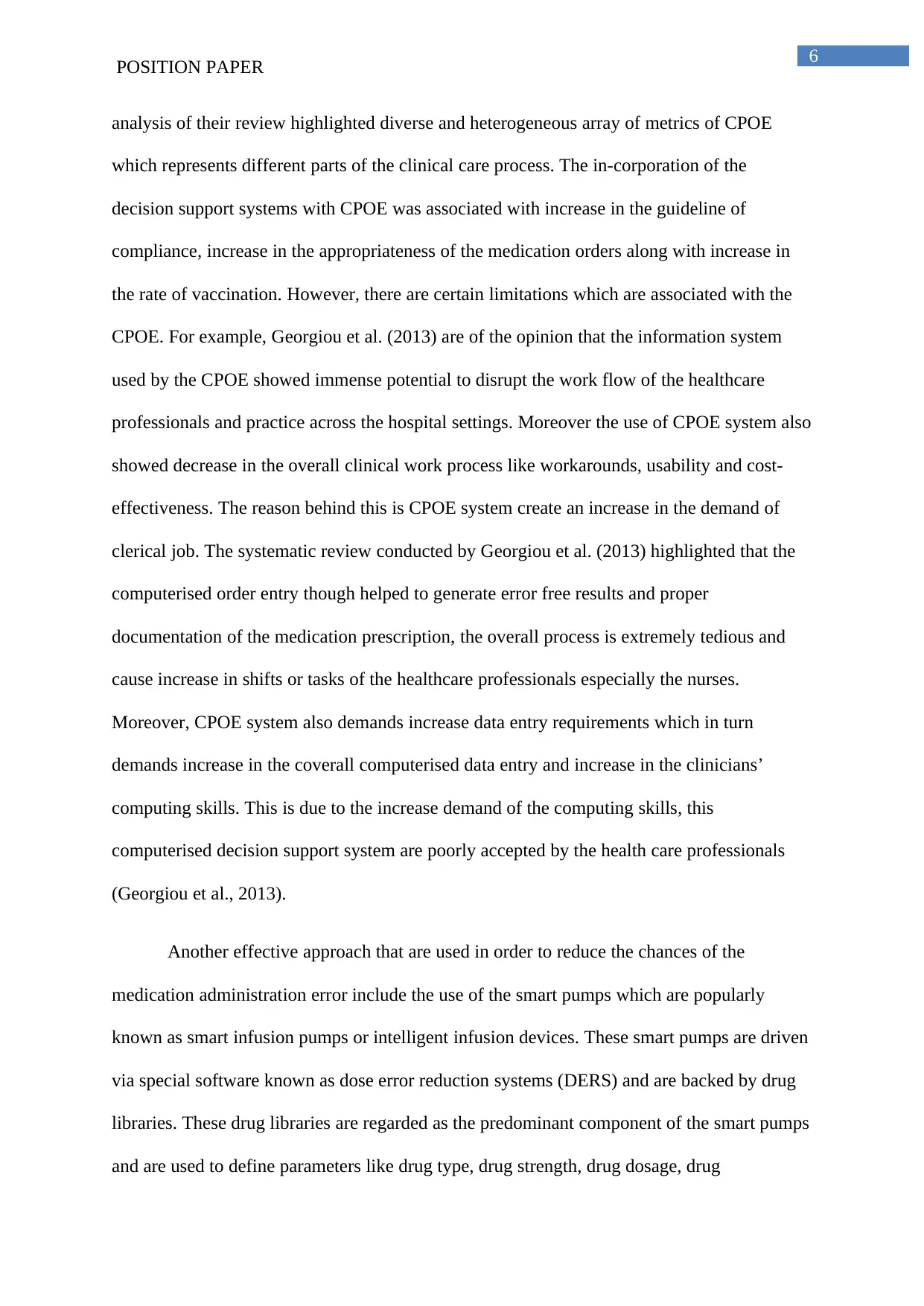
6
POSITION PAPER
analysis of their review highlighted diverse and heterogeneous array of metrics of CPOE
which represents different parts of the clinical care process. The in-corporation of the
decision support systems with CPOE was associated with increase in the guideline of
compliance, increase in the appropriateness of the medication orders along with increase in
the rate of vaccination. However, there are certain limitations which are associated with the
CPOE. For example, Georgiou et al. (2013) are of the opinion that the information system
used by the CPOE showed immense potential to disrupt the work flow of the healthcare
professionals and practice across the hospital settings. Moreover the use of CPOE system also
showed decrease in the overall clinical work process like workarounds, usability and cost-
effectiveness. The reason behind this is CPOE system create an increase in the demand of
clerical job. The systematic review conducted by Georgiou et al. (2013) highlighted that the
computerised order entry though helped to generate error free results and proper
documentation of the medication prescription, the overall process is extremely tedious and
cause increase in shifts or tasks of the healthcare professionals especially the nurses.
Moreover, CPOE system also demands increase data entry requirements which in turn
demands increase in the coverall computerised data entry and increase in the clinicians’
computing skills. This is due to the increase demand of the computing skills, this
computerised decision support system are poorly accepted by the health care professionals
(Georgiou et al., 2013).
Another effective approach that are used in order to reduce the chances of the
medication administration error include the use of the smart pumps which are popularly
known as smart infusion pumps or intelligent infusion devices. These smart pumps are driven
via special software known as dose error reduction systems (DERS) and are backed by drug
libraries. These drug libraries are regarded as the predominant component of the smart pumps
and are used to define parameters like drug type, drug strength, drug dosage, drug
POSITION PAPER
analysis of their review highlighted diverse and heterogeneous array of metrics of CPOE
which represents different parts of the clinical care process. The in-corporation of the
decision support systems with CPOE was associated with increase in the guideline of
compliance, increase in the appropriateness of the medication orders along with increase in
the rate of vaccination. However, there are certain limitations which are associated with the
CPOE. For example, Georgiou et al. (2013) are of the opinion that the information system
used by the CPOE showed immense potential to disrupt the work flow of the healthcare
professionals and practice across the hospital settings. Moreover the use of CPOE system also
showed decrease in the overall clinical work process like workarounds, usability and cost-
effectiveness. The reason behind this is CPOE system create an increase in the demand of
clerical job. The systematic review conducted by Georgiou et al. (2013) highlighted that the
computerised order entry though helped to generate error free results and proper
documentation of the medication prescription, the overall process is extremely tedious and
cause increase in shifts or tasks of the healthcare professionals especially the nurses.
Moreover, CPOE system also demands increase data entry requirements which in turn
demands increase in the coverall computerised data entry and increase in the clinicians’
computing skills. This is due to the increase demand of the computing skills, this
computerised decision support system are poorly accepted by the health care professionals
(Georgiou et al., 2013).
Another effective approach that are used in order to reduce the chances of the
medication administration error include the use of the smart pumps which are popularly
known as smart infusion pumps or intelligent infusion devices. These smart pumps are driven
via special software known as dose error reduction systems (DERS) and are backed by drug
libraries. These drug libraries are regarded as the predominant component of the smart pumps
and are used to define parameters like drug type, drug strength, drug dosage, drug
Paraphrase This Document
Need a fresh take? Get an instant paraphrase of this document with our AI Paraphraser
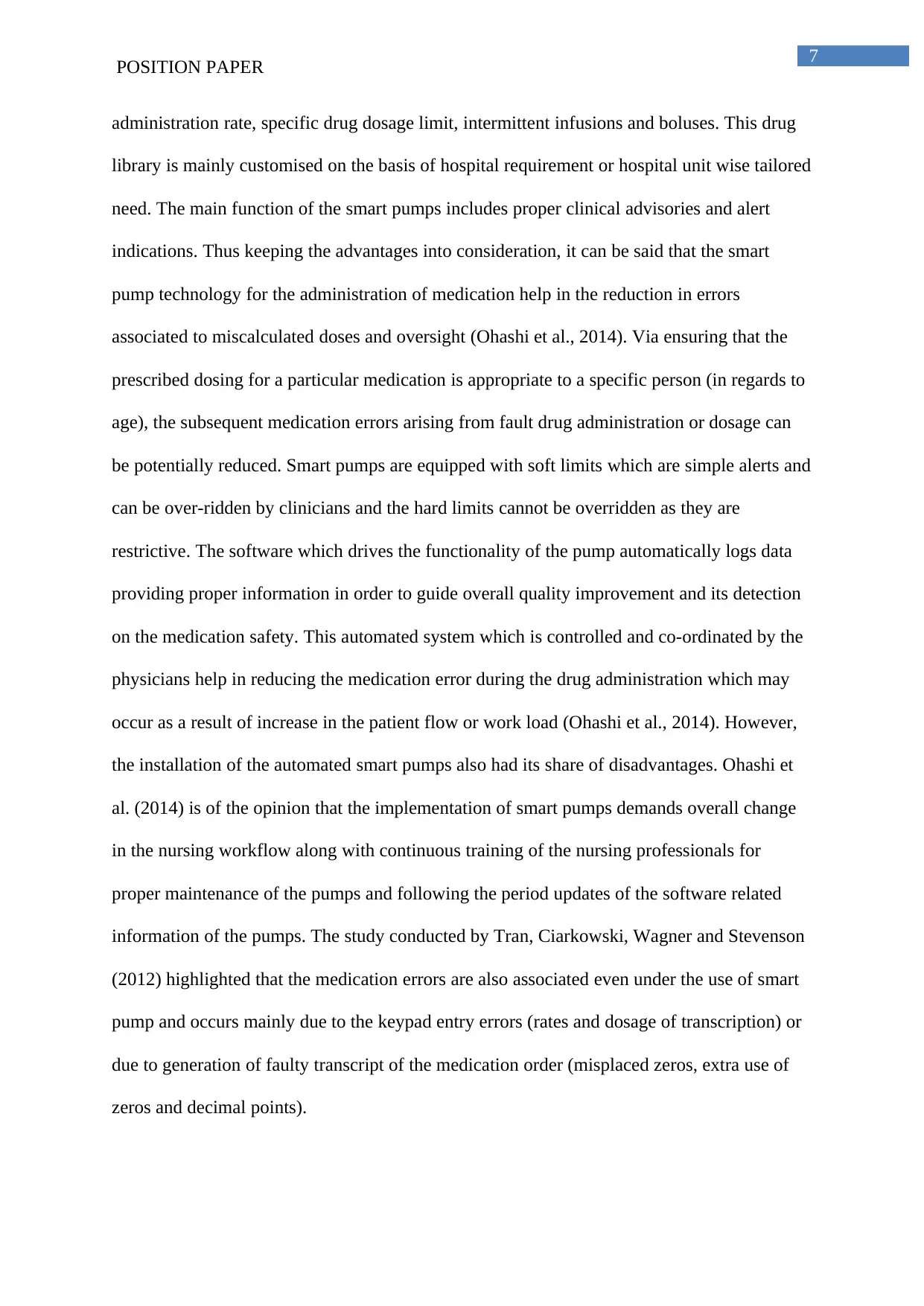
7
POSITION PAPER
administration rate, specific drug dosage limit, intermittent infusions and boluses. This drug
library is mainly customised on the basis of hospital requirement or hospital unit wise tailored
need. The main function of the smart pumps includes proper clinical advisories and alert
indications. Thus keeping the advantages into consideration, it can be said that the smart
pump technology for the administration of medication help in the reduction in errors
associated to miscalculated doses and oversight (Ohashi et al., 2014). Via ensuring that the
prescribed dosing for a particular medication is appropriate to a specific person (in regards to
age), the subsequent medication errors arising from fault drug administration or dosage can
be potentially reduced. Smart pumps are equipped with soft limits which are simple alerts and
can be over-ridden by clinicians and the hard limits cannot be overridden as they are
restrictive. The software which drives the functionality of the pump automatically logs data
providing proper information in order to guide overall quality improvement and its detection
on the medication safety. This automated system which is controlled and co-ordinated by the
physicians help in reducing the medication error during the drug administration which may
occur as a result of increase in the patient flow or work load (Ohashi et al., 2014). However,
the installation of the automated smart pumps also had its share of disadvantages. Ohashi et
al. (2014) is of the opinion that the implementation of smart pumps demands overall change
in the nursing workflow along with continuous training of the nursing professionals for
proper maintenance of the pumps and following the period updates of the software related
information of the pumps. The study conducted by Tran, Ciarkowski, Wagner and Stevenson
(2012) highlighted that the medication errors are also associated even under the use of smart
pump and occurs mainly due to the keypad entry errors (rates and dosage of transcription) or
due to generation of faulty transcript of the medication order (misplaced zeros, extra use of
zeros and decimal points).
POSITION PAPER
administration rate, specific drug dosage limit, intermittent infusions and boluses. This drug
library is mainly customised on the basis of hospital requirement or hospital unit wise tailored
need. The main function of the smart pumps includes proper clinical advisories and alert
indications. Thus keeping the advantages into consideration, it can be said that the smart
pump technology for the administration of medication help in the reduction in errors
associated to miscalculated doses and oversight (Ohashi et al., 2014). Via ensuring that the
prescribed dosing for a particular medication is appropriate to a specific person (in regards to
age), the subsequent medication errors arising from fault drug administration or dosage can
be potentially reduced. Smart pumps are equipped with soft limits which are simple alerts and
can be over-ridden by clinicians and the hard limits cannot be overridden as they are
restrictive. The software which drives the functionality of the pump automatically logs data
providing proper information in order to guide overall quality improvement and its detection
on the medication safety. This automated system which is controlled and co-ordinated by the
physicians help in reducing the medication error during the drug administration which may
occur as a result of increase in the patient flow or work load (Ohashi et al., 2014). However,
the installation of the automated smart pumps also had its share of disadvantages. Ohashi et
al. (2014) is of the opinion that the implementation of smart pumps demands overall change
in the nursing workflow along with continuous training of the nursing professionals for
proper maintenance of the pumps and following the period updates of the software related
information of the pumps. The study conducted by Tran, Ciarkowski, Wagner and Stevenson
(2012) highlighted that the medication errors are also associated even under the use of smart
pump and occurs mainly due to the keypad entry errors (rates and dosage of transcription) or
due to generation of faulty transcript of the medication order (misplaced zeros, extra use of
zeros and decimal points).
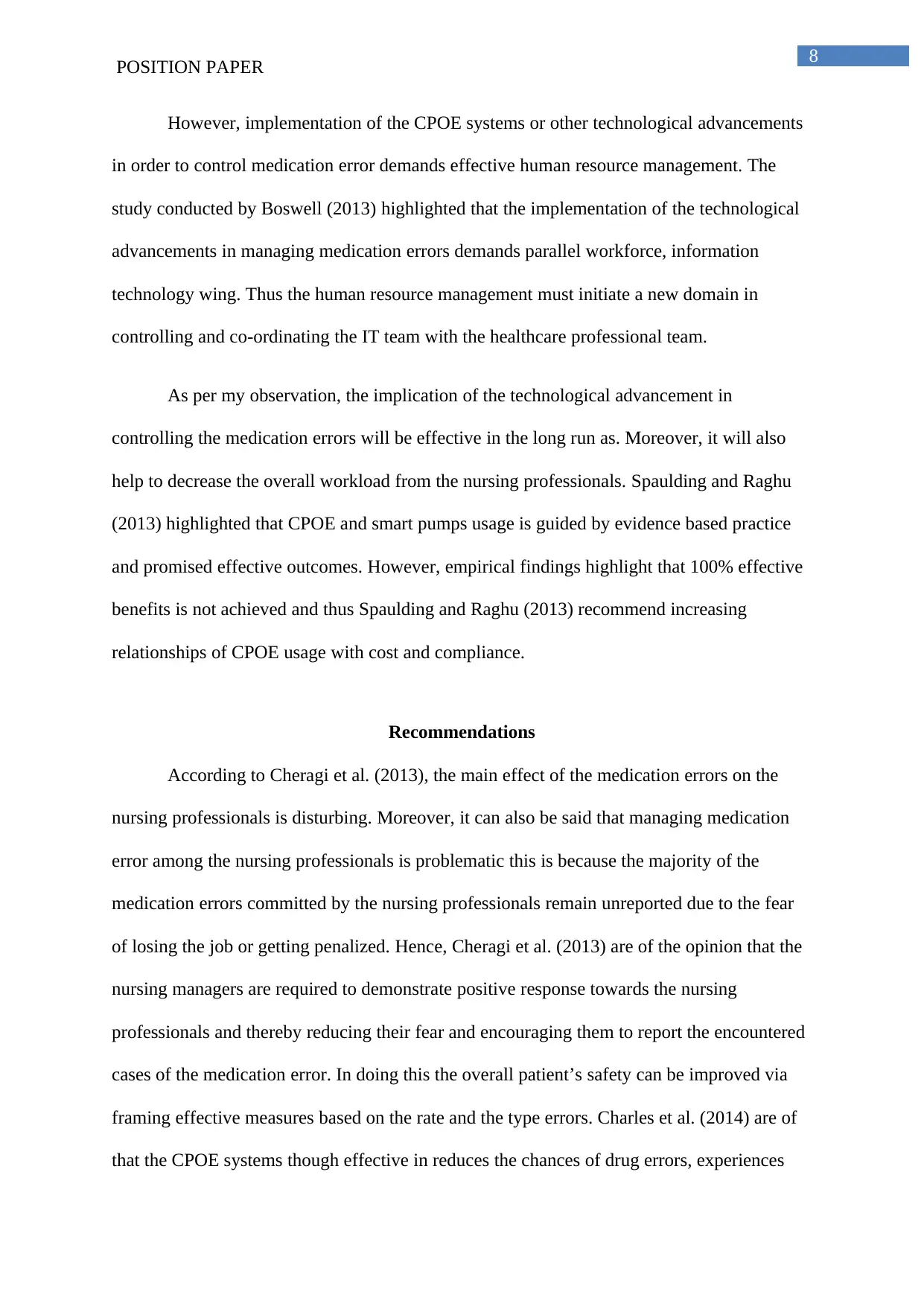
8
POSITION PAPER
However, implementation of the CPOE systems or other technological advancements
in order to control medication error demands effective human resource management. The
study conducted by Boswell (2013) highlighted that the implementation of the technological
advancements in managing medication errors demands parallel workforce, information
technology wing. Thus the human resource management must initiate a new domain in
controlling and co-ordinating the IT team with the healthcare professional team.
As per my observation, the implication of the technological advancement in
controlling the medication errors will be effective in the long run as. Moreover, it will also
help to decrease the overall workload from the nursing professionals. Spaulding and Raghu
(2013) highlighted that CPOE and smart pumps usage is guided by evidence based practice
and promised effective outcomes. However, empirical findings highlight that 100% effective
benefits is not achieved and thus Spaulding and Raghu (2013) recommend increasing
relationships of CPOE usage with cost and compliance.
Recommendations
According to Cheragi et al. (2013), the main effect of the medication errors on the
nursing professionals is disturbing. Moreover, it can also be said that managing medication
error among the nursing professionals is problematic this is because the majority of the
medication errors committed by the nursing professionals remain unreported due to the fear
of losing the job or getting penalized. Hence, Cheragi et al. (2013) are of the opinion that the
nursing managers are required to demonstrate positive response towards the nursing
professionals and thereby reducing their fear and encouraging them to report the encountered
cases of the medication error. In doing this the overall patient’s safety can be improved via
framing effective measures based on the rate and the type errors. Charles et al. (2014) are of
that the CPOE systems though effective in reduces the chances of drug errors, experiences
POSITION PAPER
However, implementation of the CPOE systems or other technological advancements
in order to control medication error demands effective human resource management. The
study conducted by Boswell (2013) highlighted that the implementation of the technological
advancements in managing medication errors demands parallel workforce, information
technology wing. Thus the human resource management must initiate a new domain in
controlling and co-ordinating the IT team with the healthcare professional team.
As per my observation, the implication of the technological advancement in
controlling the medication errors will be effective in the long run as. Moreover, it will also
help to decrease the overall workload from the nursing professionals. Spaulding and Raghu
(2013) highlighted that CPOE and smart pumps usage is guided by evidence based practice
and promised effective outcomes. However, empirical findings highlight that 100% effective
benefits is not achieved and thus Spaulding and Raghu (2013) recommend increasing
relationships of CPOE usage with cost and compliance.
Recommendations
According to Cheragi et al. (2013), the main effect of the medication errors on the
nursing professionals is disturbing. Moreover, it can also be said that managing medication
error among the nursing professionals is problematic this is because the majority of the
medication errors committed by the nursing professionals remain unreported due to the fear
of losing the job or getting penalized. Hence, Cheragi et al. (2013) are of the opinion that the
nursing managers are required to demonstrate positive response towards the nursing
professionals and thereby reducing their fear and encouraging them to report the encountered
cases of the medication error. In doing this the overall patient’s safety can be improved via
framing effective measures based on the rate and the type errors. Charles et al. (2014) are of
that the CPOE systems though effective in reduces the chances of drug errors, experiences
⊘ This is a preview!⊘
Do you want full access?
Subscribe today to unlock all pages.

Trusted by 1+ million students worldwide
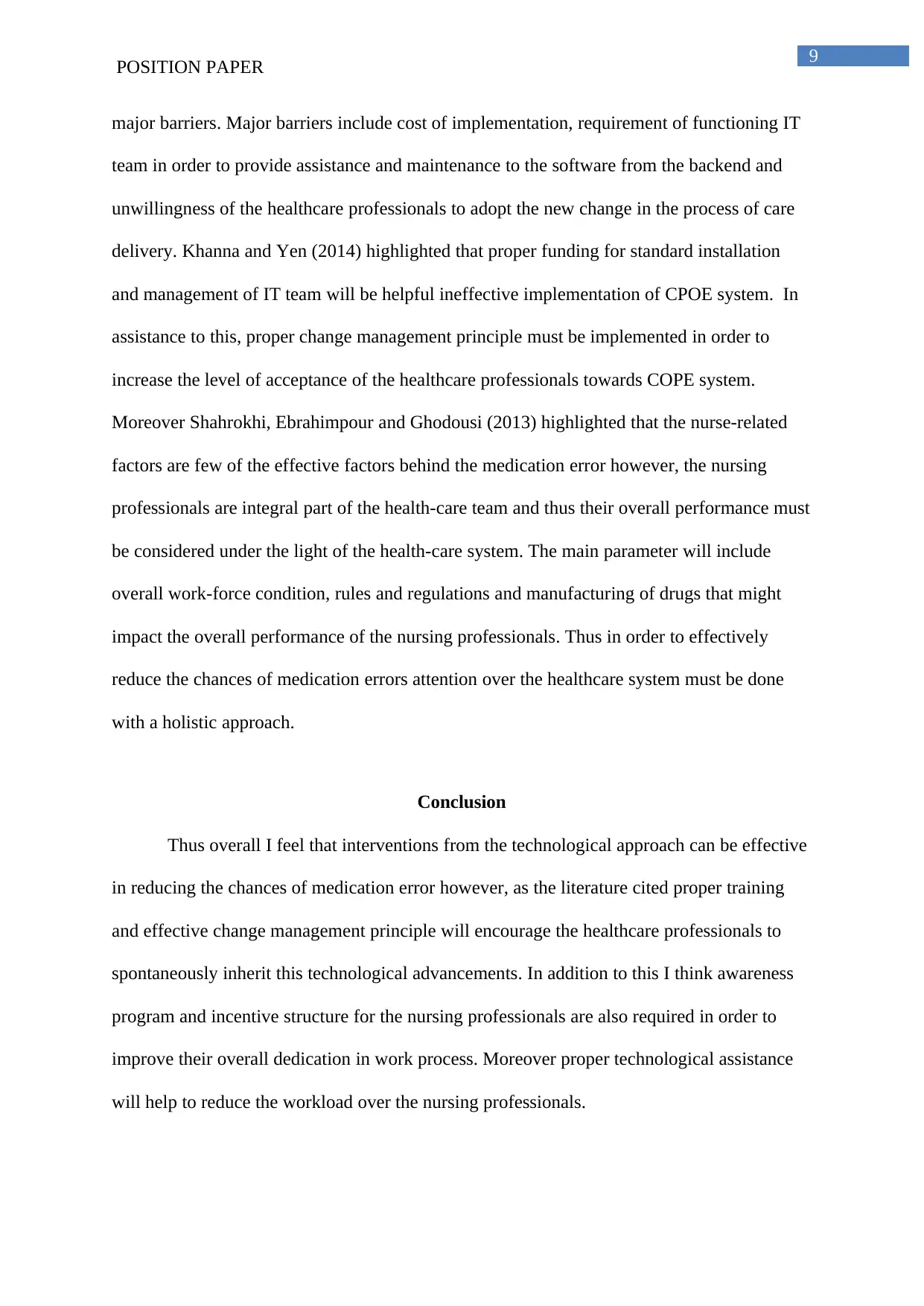
9
POSITION PAPER
major barriers. Major barriers include cost of implementation, requirement of functioning IT
team in order to provide assistance and maintenance to the software from the backend and
unwillingness of the healthcare professionals to adopt the new change in the process of care
delivery. Khanna and Yen (2014) highlighted that proper funding for standard installation
and management of IT team will be helpful ineffective implementation of CPOE system. In
assistance to this, proper change management principle must be implemented in order to
increase the level of acceptance of the healthcare professionals towards COPE system.
Moreover Shahrokhi, Ebrahimpour and Ghodousi (2013) highlighted that the nurse-related
factors are few of the effective factors behind the medication error however, the nursing
professionals are integral part of the health-care team and thus their overall performance must
be considered under the light of the health-care system. The main parameter will include
overall work-force condition, rules and regulations and manufacturing of drugs that might
impact the overall performance of the nursing professionals. Thus in order to effectively
reduce the chances of medication errors attention over the healthcare system must be done
with a holistic approach.
Conclusion
Thus overall I feel that interventions from the technological approach can be effective
in reducing the chances of medication error however, as the literature cited proper training
and effective change management principle will encourage the healthcare professionals to
spontaneously inherit this technological advancements. In addition to this I think awareness
program and incentive structure for the nursing professionals are also required in order to
improve their overall dedication in work process. Moreover proper technological assistance
will help to reduce the workload over the nursing professionals.
POSITION PAPER
major barriers. Major barriers include cost of implementation, requirement of functioning IT
team in order to provide assistance and maintenance to the software from the backend and
unwillingness of the healthcare professionals to adopt the new change in the process of care
delivery. Khanna and Yen (2014) highlighted that proper funding for standard installation
and management of IT team will be helpful ineffective implementation of CPOE system. In
assistance to this, proper change management principle must be implemented in order to
increase the level of acceptance of the healthcare professionals towards COPE system.
Moreover Shahrokhi, Ebrahimpour and Ghodousi (2013) highlighted that the nurse-related
factors are few of the effective factors behind the medication error however, the nursing
professionals are integral part of the health-care team and thus their overall performance must
be considered under the light of the health-care system. The main parameter will include
overall work-force condition, rules and regulations and manufacturing of drugs that might
impact the overall performance of the nursing professionals. Thus in order to effectively
reduce the chances of medication errors attention over the healthcare system must be done
with a holistic approach.
Conclusion
Thus overall I feel that interventions from the technological approach can be effective
in reducing the chances of medication error however, as the literature cited proper training
and effective change management principle will encourage the healthcare professionals to
spontaneously inherit this technological advancements. In addition to this I think awareness
program and incentive structure for the nursing professionals are also required in order to
improve their overall dedication in work process. Moreover proper technological assistance
will help to reduce the workload over the nursing professionals.
Paraphrase This Document
Need a fresh take? Get an instant paraphrase of this document with our AI Paraphraser
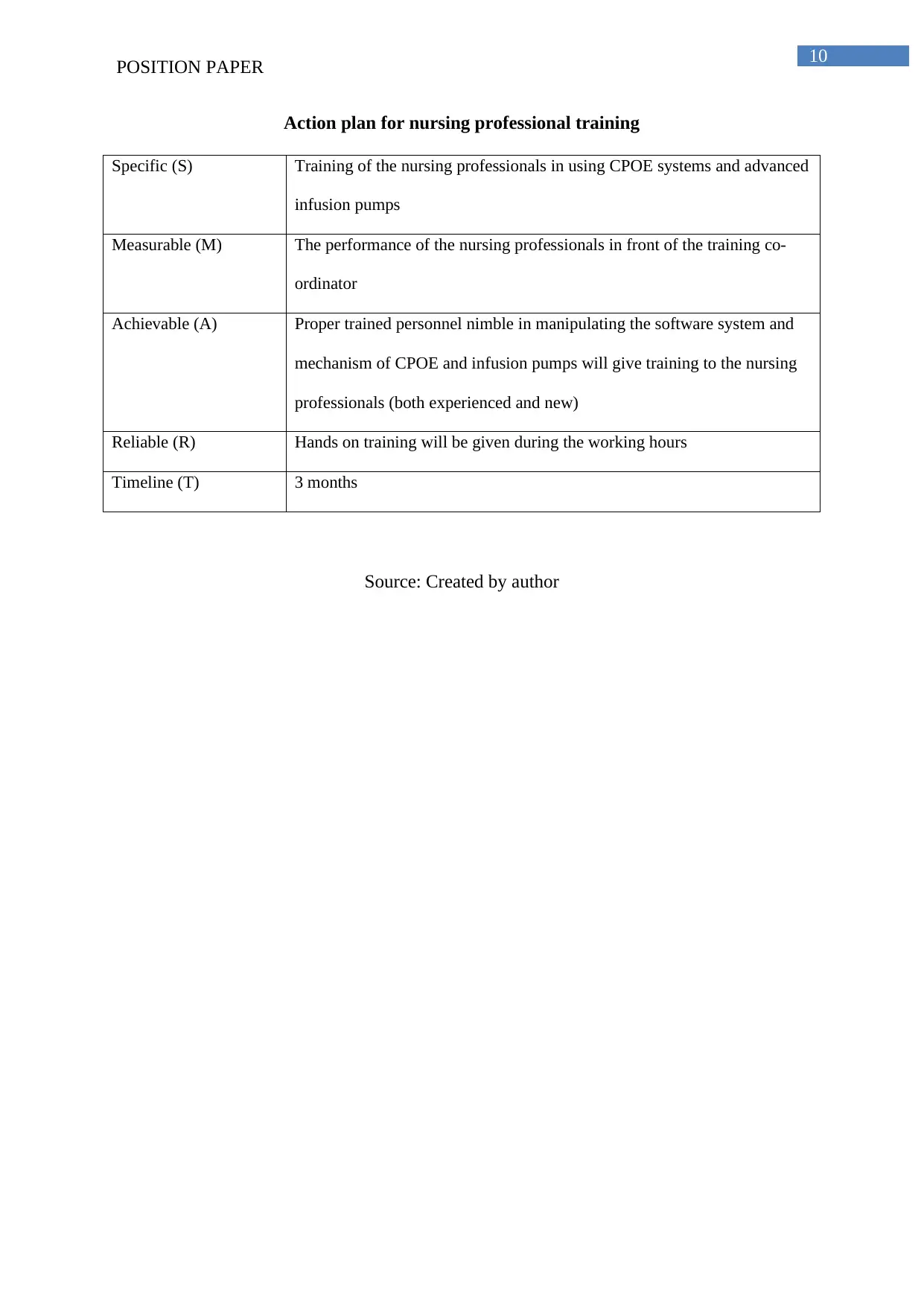
10
POSITION PAPER
Action plan for nursing professional training
Specific (S) Training of the nursing professionals in using CPOE systems and advanced
infusion pumps
Measurable (M) The performance of the nursing professionals in front of the training co-
ordinator
Achievable (A) Proper trained personnel nimble in manipulating the software system and
mechanism of CPOE and infusion pumps will give training to the nursing
professionals (both experienced and new)
Reliable (R) Hands on training will be given during the working hours
Timeline (T) 3 months
Source: Created by author
POSITION PAPER
Action plan for nursing professional training
Specific (S) Training of the nursing professionals in using CPOE systems and advanced
infusion pumps
Measurable (M) The performance of the nursing professionals in front of the training co-
ordinator
Achievable (A) Proper trained personnel nimble in manipulating the software system and
mechanism of CPOE and infusion pumps will give training to the nursing
professionals (both experienced and new)
Reliable (R) Hands on training will be given during the working hours
Timeline (T) 3 months
Source: Created by author
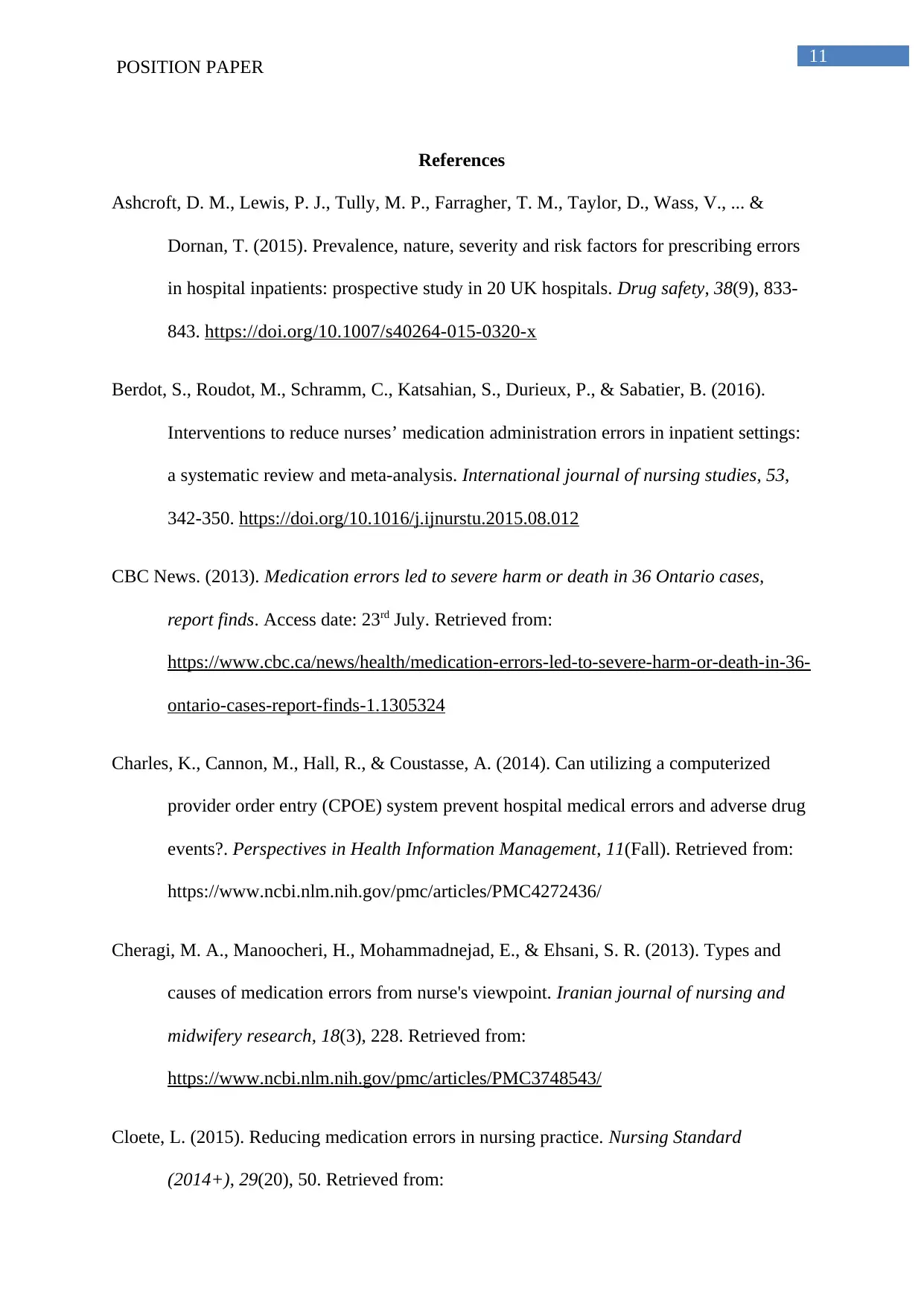
11
POSITION PAPER
References
Ashcroft, D. M., Lewis, P. J., Tully, M. P., Farragher, T. M., Taylor, D., Wass, V., ... &
Dornan, T. (2015). Prevalence, nature, severity and risk factors for prescribing errors
in hospital inpatients: prospective study in 20 UK hospitals. Drug safety, 38(9), 833-
843. https://doi.org/10.1007/s40264-015-0320-x
Berdot, S., Roudot, M., Schramm, C., Katsahian, S., Durieux, P., & Sabatier, B. (2016).
Interventions to reduce nurses’ medication administration errors in inpatient settings:
a systematic review and meta-analysis. International journal of nursing studies, 53,
342-350. https://doi.org/10.1016/j.ijnurstu.2015.08.012
CBC News. (2013). Medication errors led to severe harm or death in 36 Ontario cases,
report finds. Access date: 23rd July. Retrieved from:
https://www.cbc.ca/news/health/medication-errors-led-to-severe-harm-or-death-in-36-
ontario-cases-report-finds-1.1305324
Charles, K., Cannon, M., Hall, R., & Coustasse, A. (2014). Can utilizing a computerized
provider order entry (CPOE) system prevent hospital medical errors and adverse drug
events?. Perspectives in Health Information Management, 11(Fall). Retrieved from:
https://www.ncbi.nlm.nih.gov/pmc/articles/PMC4272436/
Cheragi, M. A., Manoocheri, H., Mohammadnejad, E., & Ehsani, S. R. (2013). Types and
causes of medication errors from nurse's viewpoint. Iranian journal of nursing and
midwifery research, 18(3), 228. Retrieved from:
https://www.ncbi.nlm.nih.gov/pmc/articles/PMC3748543/
Cloete, L. (2015). Reducing medication errors in nursing practice. Nursing Standard
(2014+), 29(20), 50. Retrieved from:
POSITION PAPER
References
Ashcroft, D. M., Lewis, P. J., Tully, M. P., Farragher, T. M., Taylor, D., Wass, V., ... &
Dornan, T. (2015). Prevalence, nature, severity and risk factors for prescribing errors
in hospital inpatients: prospective study in 20 UK hospitals. Drug safety, 38(9), 833-
843. https://doi.org/10.1007/s40264-015-0320-x
Berdot, S., Roudot, M., Schramm, C., Katsahian, S., Durieux, P., & Sabatier, B. (2016).
Interventions to reduce nurses’ medication administration errors in inpatient settings:
a systematic review and meta-analysis. International journal of nursing studies, 53,
342-350. https://doi.org/10.1016/j.ijnurstu.2015.08.012
CBC News. (2013). Medication errors led to severe harm or death in 36 Ontario cases,
report finds. Access date: 23rd July. Retrieved from:
https://www.cbc.ca/news/health/medication-errors-led-to-severe-harm-or-death-in-36-
ontario-cases-report-finds-1.1305324
Charles, K., Cannon, M., Hall, R., & Coustasse, A. (2014). Can utilizing a computerized
provider order entry (CPOE) system prevent hospital medical errors and adverse drug
events?. Perspectives in Health Information Management, 11(Fall). Retrieved from:
https://www.ncbi.nlm.nih.gov/pmc/articles/PMC4272436/
Cheragi, M. A., Manoocheri, H., Mohammadnejad, E., & Ehsani, S. R. (2013). Types and
causes of medication errors from nurse's viewpoint. Iranian journal of nursing and
midwifery research, 18(3), 228. Retrieved from:
https://www.ncbi.nlm.nih.gov/pmc/articles/PMC3748543/
Cloete, L. (2015). Reducing medication errors in nursing practice. Nursing Standard
(2014+), 29(20), 50. Retrieved from:
⊘ This is a preview!⊘
Do you want full access?
Subscribe today to unlock all pages.

Trusted by 1+ million students worldwide
1 out of 15
Related Documents
Your All-in-One AI-Powered Toolkit for Academic Success.
+13062052269
info@desklib.com
Available 24*7 on WhatsApp / Email
![[object Object]](/_next/static/media/star-bottom.7253800d.svg)
Unlock your academic potential
Copyright © 2020–2025 A2Z Services. All Rights Reserved. Developed and managed by ZUCOL.





